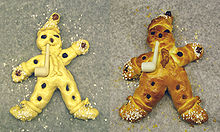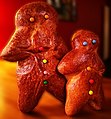Mare guy
As Stutenkerl , Weck (s) mann , Klaus Mann , Hefemänne , Grättimaa , Grittibänz , Dambedei , Weckbobbe , Pumann , Bubbelai or Krampus a Gebildbrot of dough referred to.
The pastry in the shape of a stylized man has its main season in autumn and winter. It is produced and eaten in North Rhine-Westphalia, Hesse or Eichsfeld around St. Martin's Day on November 11th. As a mare guy, it's a typical Advent pastry in many places ; in other areas it is also eaten in January or is independent of dates at all. Depending on the region, the outer shape refers to Bishop Nicholas of Myra and his feast day on December 6th or to Saint Martin . In the past, other references also occurred (see below).
A mostly sweetened yeast dough (weck, mares) is used. Often the pastries are decorated with raisins for the face and the button placket, sometimes dusted with sugar, and a stylized pipe made of plaster of paris is often inserted.
Names
The pastries have a wide variety of names. Distributed in Rheinland , the Pfalz , in Hesse and in Baden-Württemberg , francs and in other parts of North and partially also in East Germany is Weckmann, Weckenmann or -männchen. Stutenkerl or mare male applies particularly in Lower Saxony , Schleswig-Holstein , Mecklenburg and Westphalia , i.e. the area in which the term mares is the common variant for a raisin bread. In southern Germany and Austria , the pastry is known as Krampus, referring to a frightening figure accompanied by Saint Nicholas . In East Germany, the pastry is generally not very widespread.
In addition, there are regionally coined names with a lower distribution: from the northern Eifel to Cologne it is called Pitschmann, in the western Ruhr area and Rhineland it is more likely to be called Pumann, in the dialects of Viersen , Mönchengladbach and their wider surroundings Buckmann or Buggemann . In Ostwestfalen-Lippe and eastern Münsterland he is also known as the Kiepenkerl . In northern Rhineland-Palatinate it is called Ditz, in the northern Baden-Palatinate-South Hessian area Dambedei, Maddinsmändl or Hefekerl, and in Eichsfeld one speaks of Martinsbrot . In Hessen, especially in the Rheingau , there is the Weggbopp . In the area between the Danube and Lech ( Bavarian Swabia and north of Lake Constance) the dough man is said to be Klausenmann, and in the area around Breisach he is the Basel man . In Switzerland the pastry is mostly called Grittibänz, in Basel (and southwest Baden ) Grättimaa, in western Thurgau and in the eastern canton of Zurich Elggermaa . In Luxembourg it is called Boxemännchen ( plural : Boxemännercher ), in Alsace Manele (Männele), in Franche-Comté and in Lorraine Jean Bonhomme . Finally, in the Netherlands one speaks of Buikman, Wekkeman, Weckman, Weggekèl, Mikkeman, Stevensman, Piepespringer or Ziepesjprengert .
The names Stutenkerl and Weckmann refer to the type of dough and shape of the pastry: a little man made from flour, sugar, fat and yeast ( mares ) or from flour, salt, yeast and water (Wecken) . Klausenmann takes its name from St. Nicholas. Buckmann refers to the dough man's fat belly. Grittibänz and Grättimaa show the spread legs of the little pastry man. Dambedei is of unclear origin. Terms such as Männlein and the common basic word -mann in Buckmann, Weckmann or Klausenmann and -kerl as in Stutenkerl refer to the human figure of the pastry.
Origin, meaning and customs
The pastry figure originally represented a bishop (St. Nikolaus or St. Martin), whereas today's clay pipe, which is mainly added to the North German variants and the Rhenish wake-up men at St. Martin , is supposed to represent the bishop 's staff . This is said to come from the heyday of pipe bakeries in Europe in the 17th and 18th centuries and could have been influenced by the Reformation to secularize Catholic symbols. The mare guy had a common hand on the pipe, which is also considered a “symbol of masculinity”.
In other regions, for example in German-speaking Switzerland, the Grittibänz traditionally has no pipe; it - or a rod - has only recently been added by bakeries. The identification with Nikolaus or Martin is not given in all landscapes; the pastries in Solothurn in the 19th century showed a “striking resemblance” to the state saint, the knight St. Ursus . In older times, female figures were by no means rare; This is what the Zurich reformer Heinrich Bullinger said in 1546: "Felix will take the first s'Horn, he will eat the Frowli [Fräulein] tomorrow".
In some places the dough man is not eaten on St. Nicholas Day, but at St. Martin . In the Rhineland, in the Ruhr area, in Hesse, in Westphalia, in the Rhine-Neckar region , in the (Catholic) Eichsfeld or in the (Protestant) Ravensberger Land - for example in Bickenriede - the Weckmann is given to the children at Martinssingen or after the St. Martins parade eaten. In the canton of Solothurn was Grittibänz contrast, in the 19th century usually only between Christmas and Sebastianstag (January 20) baked. In the city of Basel , Grättimaa was eaten earlier on Christmas Day; the shift to December 6th did not take place until the 20th century.
The Stutenkerl is in the series of formations loaves , which in the early Middle Ages, the penitents and the sick, the Eucharist , had not received as Communion replacement were administered. In the Eastern European Orthodox liturgy , this custom has survived to this day.
Web links
- Recipe in the Koch-Wiki
- Geographical distribution of the various names in the atlas for everyday German language
- Christoph Landolt : Grättimaa, Grittibänz and Elggermaa . In: Wortgeschichten from December 5, 2012, ed. from the editors of the Swiss Idiotikon .
- Grittibänz / Saint Nicolas / Pupazzo di San Nicolao . In: Switzerland's Culinary Heritage .
Individual evidence
- ↑ a b Geographical distribution of the various names in the atlas on everyday German language .
- ^ Rhenish dictionary , Volume I, column 523.
- ↑ Christoph Landolt: Grättimaa, Grittibänz and Elggermaa . In: Wortgeschichten from December 5, 2012, ed. from the editors of the Swiss Idiotikon .
- ↑ Baden Dictionary , Volume I, page 412 f., Article Dampedei, and page 451, Article Deien .
- ^ Westdeutsche Zeitung: Whistle instead of bishop's staff due to the Reformation , November 28, 2006.
- ↑ See e.g. B .: Only real with hand on the clay pipe, in: Weckmann ; “That's why the weckman loses his pipe”, in: Smoking ban - That's why the weckman loses his pipe .
- ↑ a b Schweizerisches Idiotikon , Volume IV, Column 1410, Article Gritti-Benz .
- ↑ Grittibänz / Saint Nicolas / Pupazzo di San Nicola . In: Switzerland's Culinary Heritage .
- ↑ https://web.archive.org/web/20140419220800/http://www.wormser-zeitung.de/lokales/worms/stadtteile-worms/abenheim/vier-mal-st-martin_12576883.htm
- ↑ https://www.morgenweb.de/region/bewohner-feierten-sankt-martin-1.802102
- ↑ https://www.morgenweb.de/region/bergstrasser-anzeiger/bensheim/mit-bunten-laternen-durch-schwanheim-1.797890 .
- ^ Eduard Strübin: Annual custom in the course of time. Verlag des Kantons Basel-Land, Liestal 1991; see also the article Grittibänz / Saint Nicolas / Pupazzo di San Nicolao in: Culinary Heritage of Switzerland .





